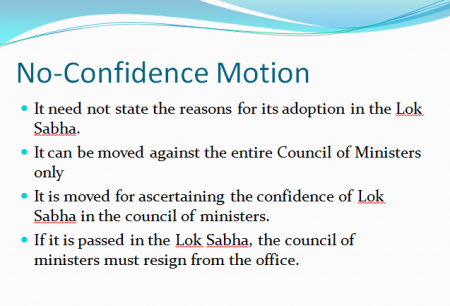Motion of No-confidence: Complete details 25/06/2019 – Posted in: Daily News – Tags: lok sabha
NO-CONFIDENCE MOTION
For: Preliminary & Mains
Topics covered: No confidence motion, procedure, who can introduce, it’s voting
News Flash
The Tamil Nadu assembly will take up the DMK’s notice for a ‘no confidence’ motion against speaker P.Dhanapal.
No-Confidence Motion
A no-confidence motion can be moved by any member of the House. It can be moved only in the Lok Sabha and not Rajya Sabha.
If the government has to demonstrate its strength on the floor of the House, it can have a motion of confidence. However, the opposition parties (or any member) can move a motion expressing want of confidence in the Council of Ministers.
A government can function only when it has majority support in the Lok Sabha. The party can remain in power when it shows its strength through a floor test which is primarily taken to know whether the executive enjoys the confidence of the legislature.
Motion: In parliamentary parlance, it means any formal proposal made by a member for the purpose of eliciting a decision of the House. If adopted (voted), it amounts to expressing the will of the House. Any matter of importance can be the subject of the motion.
No-Confidence Procedure
- Rule 198 of the Rules of Procedure and conduct of Lok Sabha specifies the procedure for moving a no-confidence motion.
- The Speaker’s permission is required first, and the motion has to be supported by at least 50 MPs.
- Sometimes the Speaker can refuse to admit the motion too. The Speaker then sets a day/days within the next 10 days, and also allows time for members’.
How is the voting done?
These are the modes by which voting can be conducted:
- Voice vote: In a voice vote, the legislators respond orally.
- Division vote: In the case of a division vote, voting is done using electronic gadgets, slips or in a ballot box.
- Ballot vote: Ballot box is usually a secret vote – just like how people vote during state or parliamentary elections.
What happens if there is a tie?
In case there is a tie, the speaker can cast his vote.
Source: Economic Times
You can follow us on LinkedIn and for more updates related to UPSC IAS Preparation, Like our Facebook Page and subscribe our Diligent IAS Youtube Channel
Also, Read Related Daily News
- Regional Comprehensive Economic Partnership
- Man-Portable Anti-Tank Guided Missile
- Directorate of Revenue Intelligence
- US report on Religious Freedom
- Southwest Monsoon
- National Employment Board

